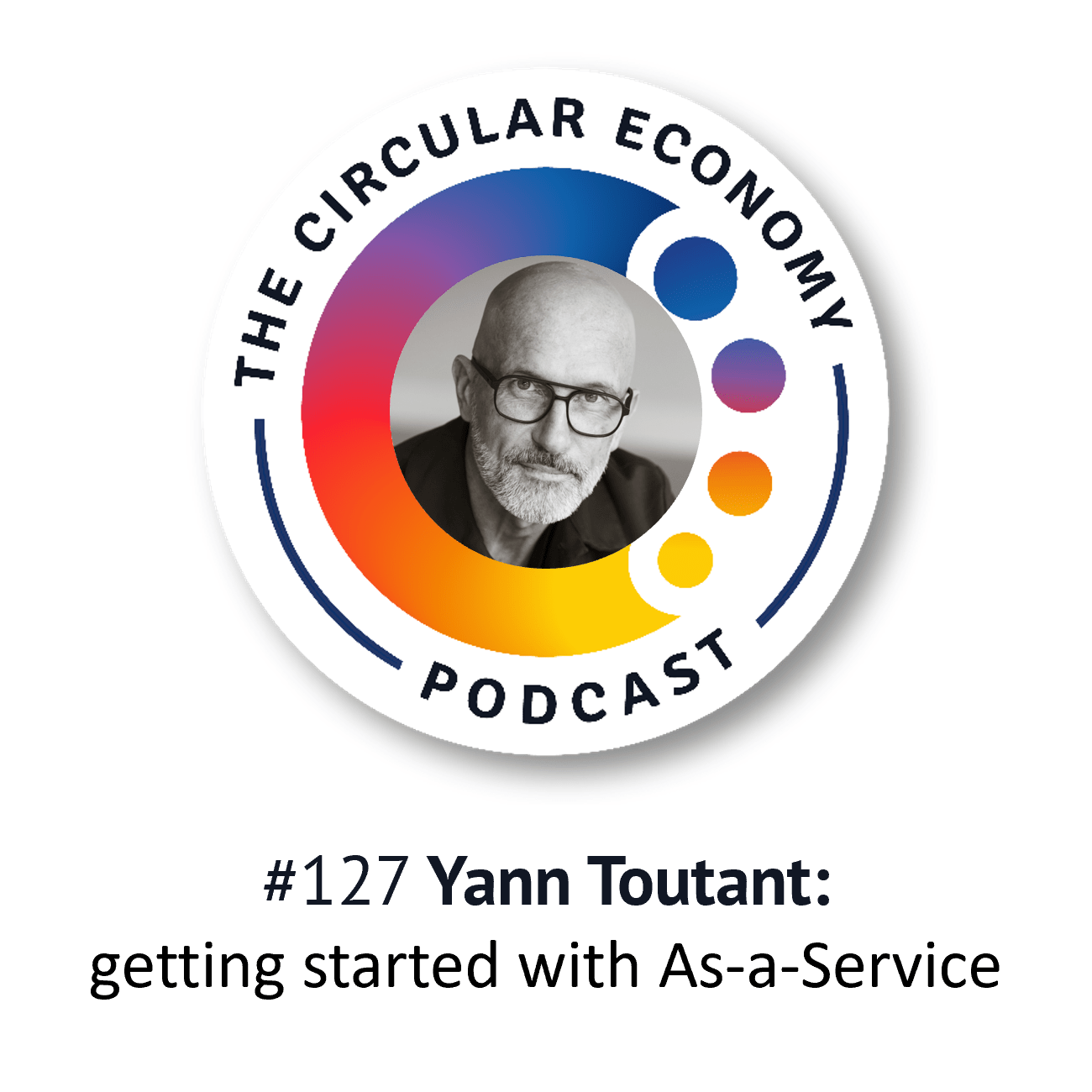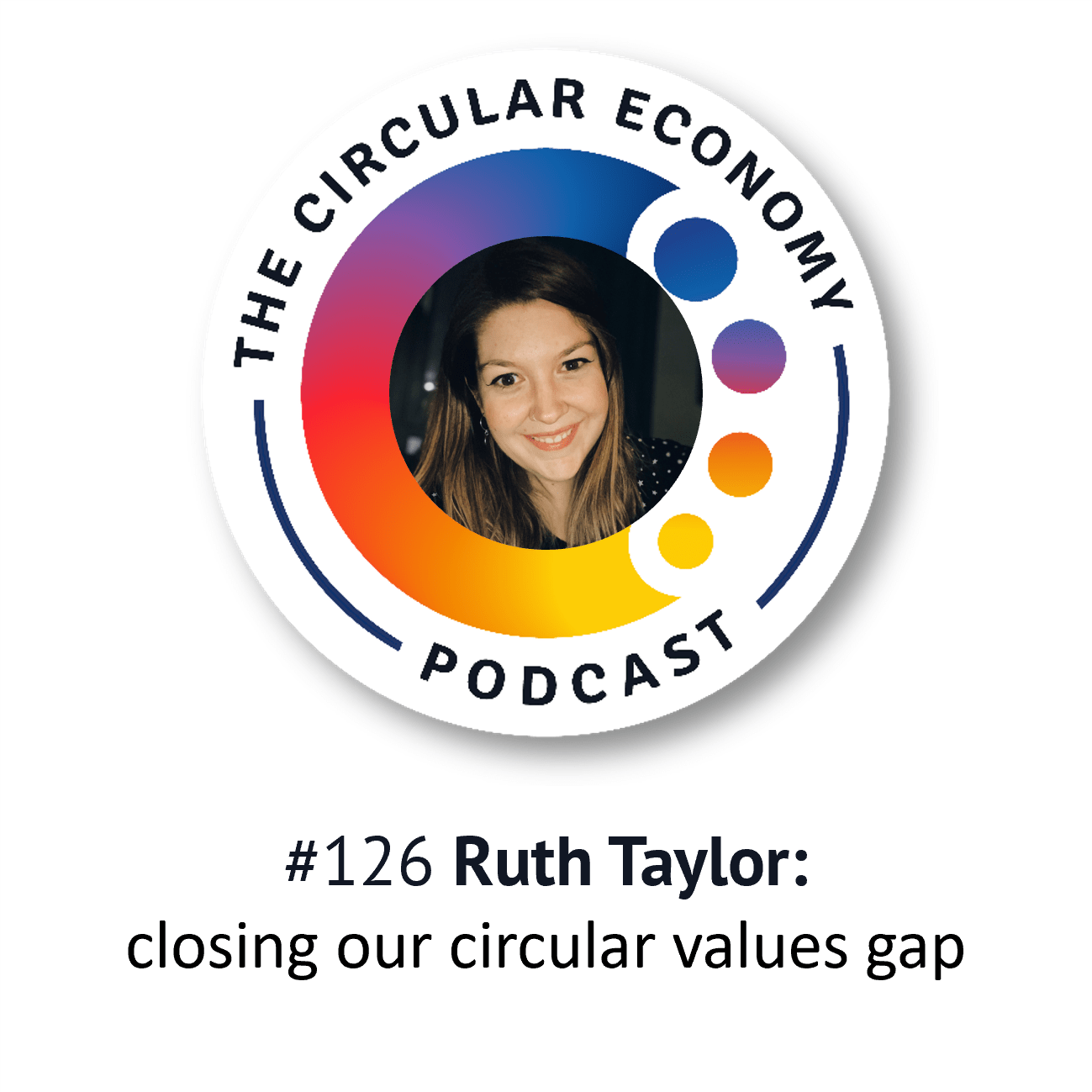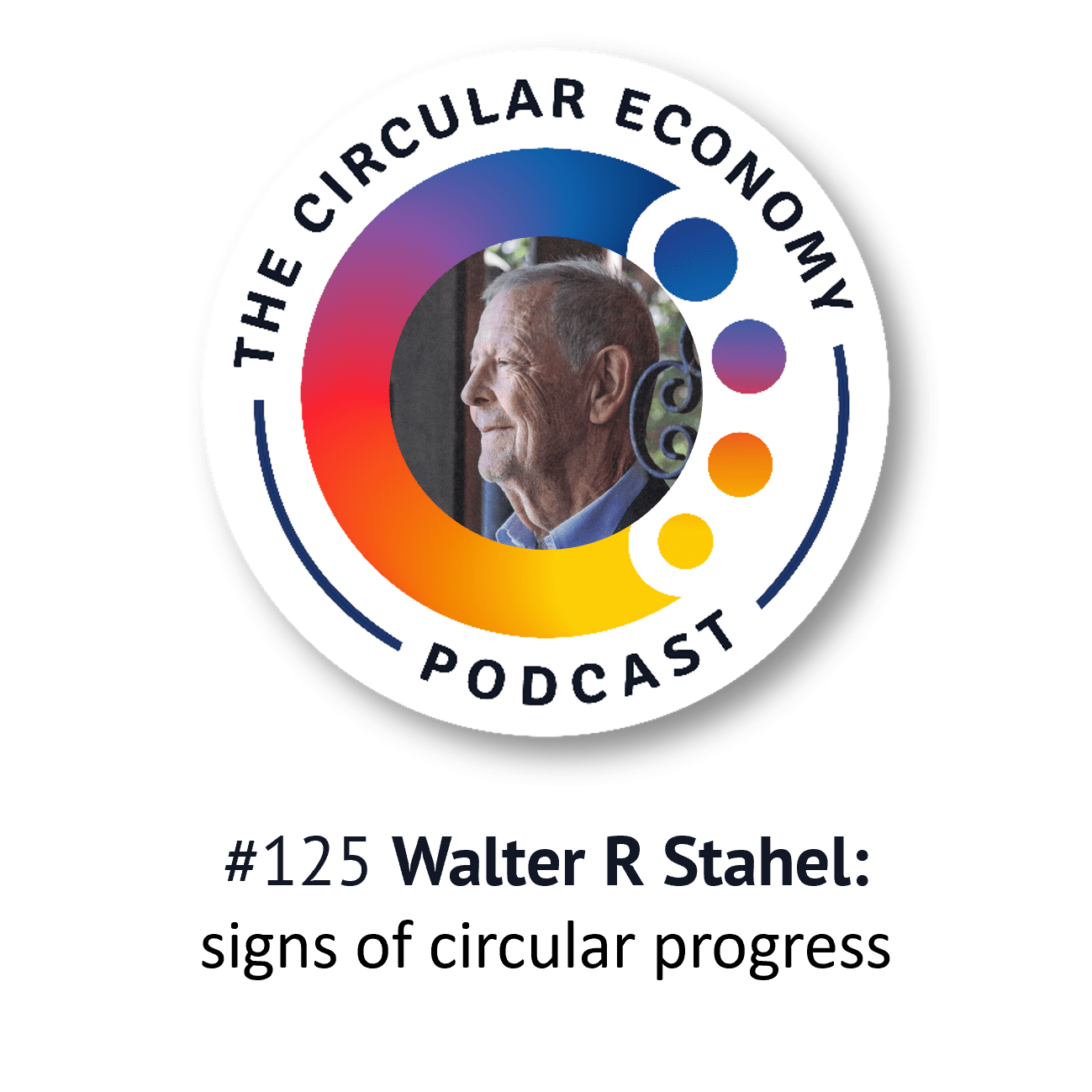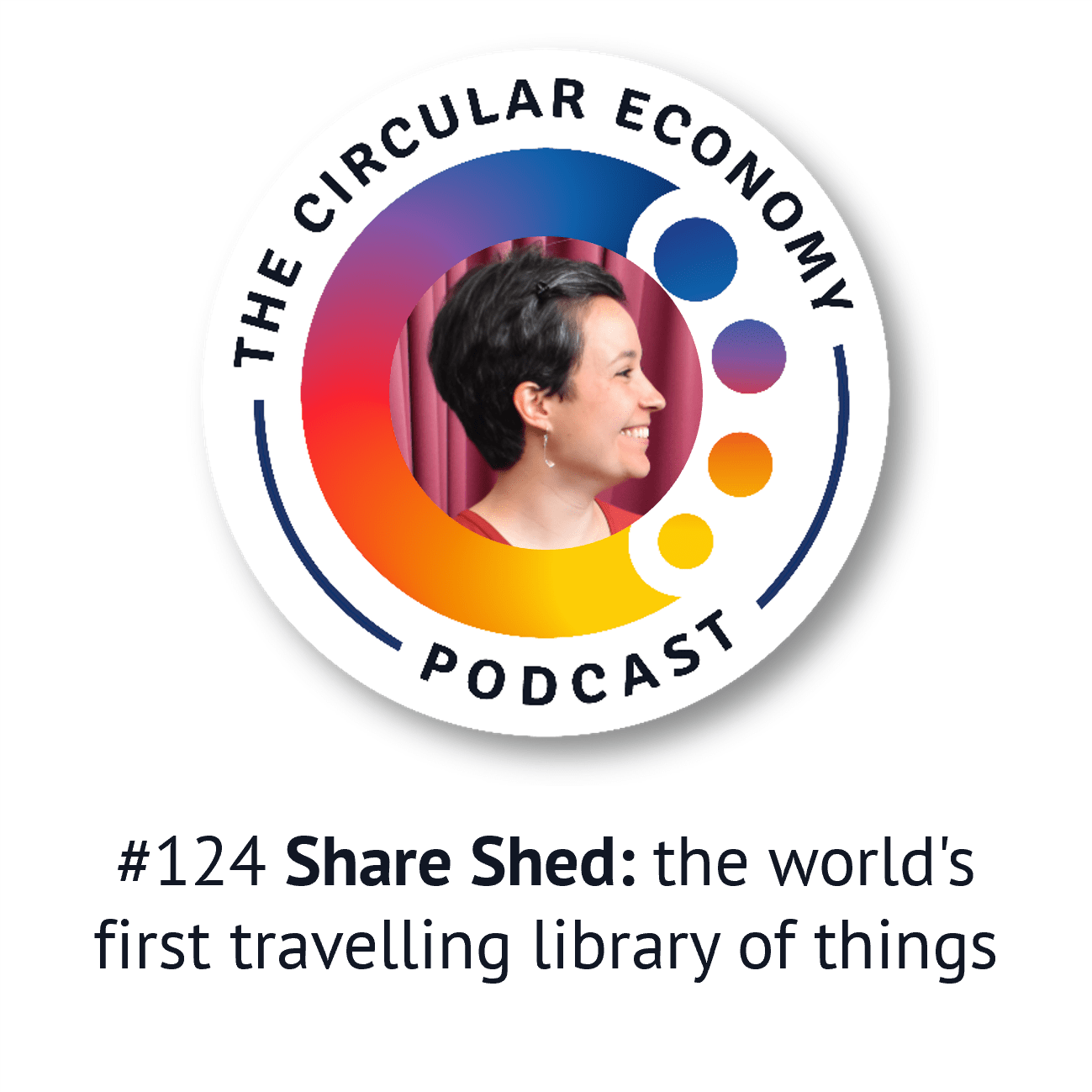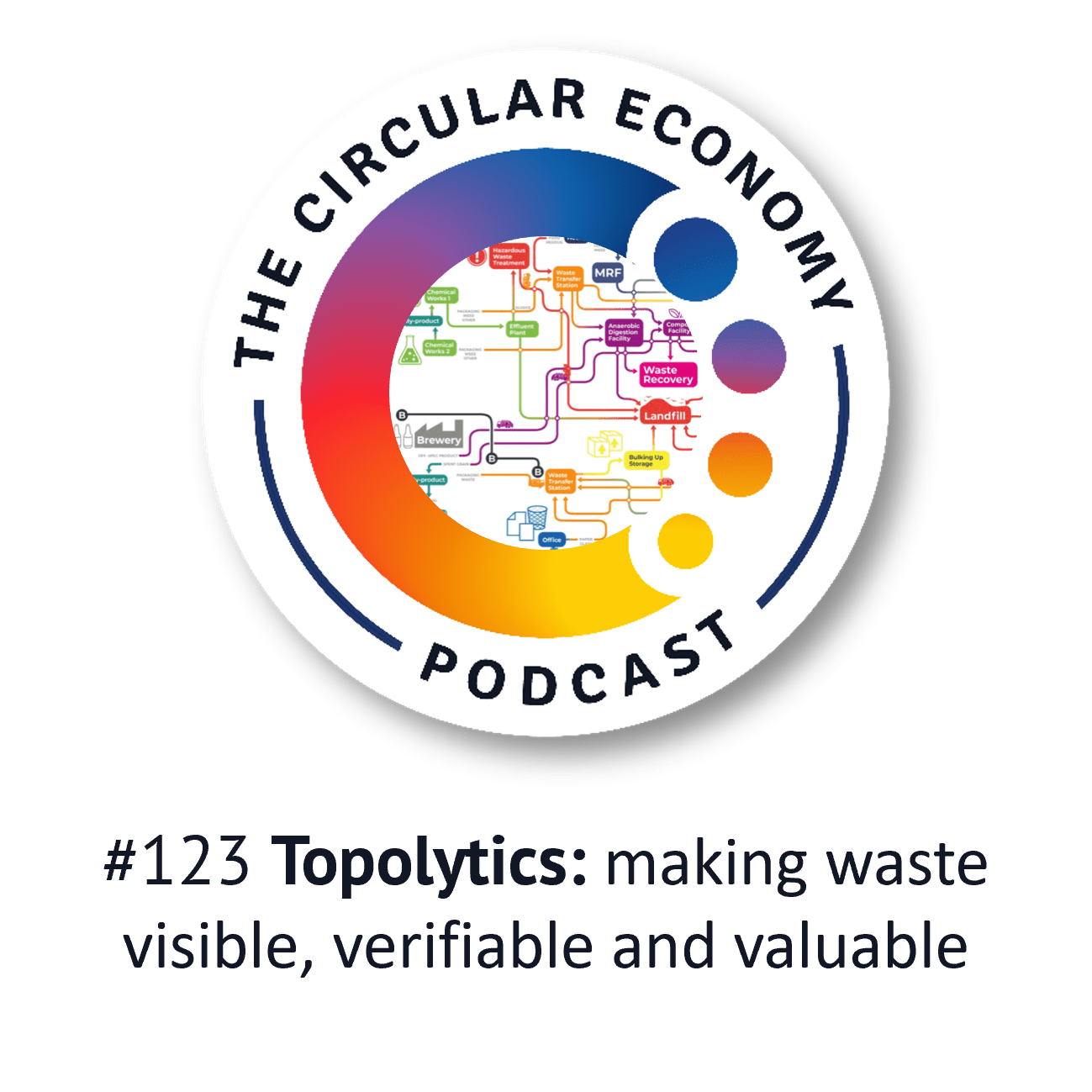Podcast: Play in new window | Download
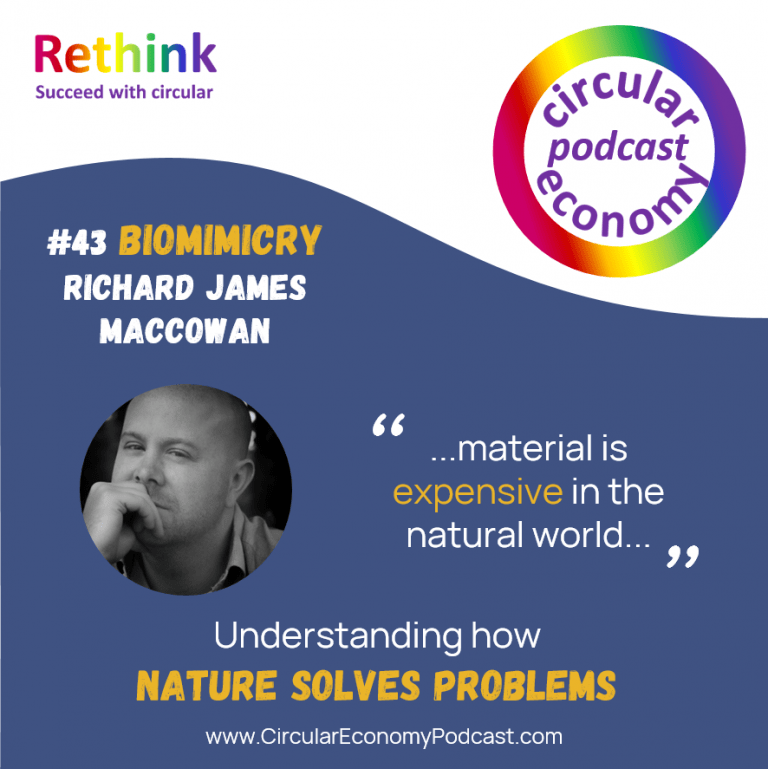
Catherine Weetman talks to Richard James MacCowan, who helps people use biomimicry to design better materials, products, buildings, and cities.
Richard is the Founder and Creative Director of the Biomimicry Innovation Lab, with a mission to inspire and share how the natural world can deliver unique solutions by radically reducing the need for resources. Richard kindly wrote a brilliant piece on Biomimicry for the 2nd edition of Catherine’s Circular Economy Handbook.
We talk about different aspects of biomimicry and how it can inform the design of objects, systems and much more, including Structure and materials, Swarm behaviour, 3D Printing & termites, Self-repairing and ‘exotic’ materials – and why origami is useful! Richard explains how nature uses structure for colour, which leads me to ask whether some of these developments are actually encouraging consumption.
Podcast host Catherine Weetman is a circular economy business advisor, workshop facilitator, speaker and writer. Her award-winning book: A Circular Economy Handbook: How to Build a More Resilient, Competitive and Sustainable Business includes lots of practical examples and tips on getting started. Catherine founded Rethink Global in 2013, to help businesses use circular, sustainable approaches to build a better business (and a better world).
Stay in touch for free insights and updates…
Read on for a summary of the podcast and links to the people, organisations and other resources we mention.
You can subscribe to the podcast series on iTunes, Google Podcasts, PlayerFM, Spotify, TuneIn, or search for “circular economy” in your favourite podcast app. Stay in touch to get free insights and updates, direct to your inbox…
Links we mention in the episode:
- A Circular Economy Handbook: How to Build a More Resilient, Competitive and Sustainable Business
- Biomimicry Innovation Lab https://biomimicryinnovationlab.com/
- Social Media – @biomimicryUK
- https://biologydictionary.net/biomimicry/ with a few examples and quick quiz
- More about the Logoplaste plastic bottle https://www.logoplaste.com/media/2282/logoplaste_case_study_vitalis_2018.pdf
- 3D printing and termites Termites and 3D printing https://www.youtube.com/watch?v=t1LbWgePCgo&t=123s
- https://biomimicry.org/zygote-quarterly/
- Dr Rupert Soar at Nottingham Trent University https://www.ntu.ac.uk/staff-profiles/architecture-design-built-environment/rupert-c-soar
- Zygote Quarterly journal https://zqjournal.org/
- Professor Peter Head of Resilience Brokers https://resiliencebrokers.org/ and https://www.pivotprojects.org
- Book: Braiding Sweetgrass by Robin Wall Kimmerer https://milkweed.org/book/braiding-sweetgrass
About Richard James MacCowan
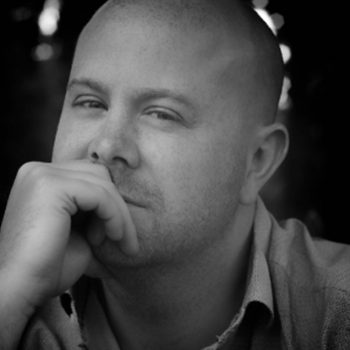 Richard is the Founder of Biomimicry Innovation Lab focusing on the food, manufacturing and built environment sectors. He is the co-founder of the non-profit Biomimicry UK and CEO of Smart Stable Limited, an equine technology startup. Alongside this, Richard is a visiting lecturer at several universities around the world. He combines this with extensive research development with international collaborators via the Design Society and the ISO Standards in Biomimetics.
Richard is the Founder of Biomimicry Innovation Lab focusing on the food, manufacturing and built environment sectors. He is the co-founder of the non-profit Biomimicry UK and CEO of Smart Stable Limited, an equine technology startup. Alongside this, Richard is a visiting lecturer at several universities around the world. He combines this with extensive research development with international collaborators via the Design Society and the ISO Standards in Biomimetics.
Richard loves to explore fresh ideas and concepts and is ever curious about the environment around him. He is an award-winning designer and has worked around the world in cities, manufacturing, food systems and product design.
Richard’s passion is developing new models of innovation to reduce costs, improve efficiency and resilience in the design and manufacturing process. He taught at some of the top design schools in the world: from The Royal College of Art (UK); The Pratt Institute (USA); Vellore Institute of Technology (India); and the Budapest University of Technology and Economics (Hungary).
Interview Transcript
Provided by AI – add 3:08 mins for the finished episode
Catherine Weetman 00:01
Richard James MacCowan is the founder of Biomimicry Innovation Lab, focusing on the food manufacturing and built environment sectors. He’s the co founder of a non-profit, Biomimicry UK and CEO of Smart Stable Limited, an equine technology startup. Alongside this, Richard is a visiting lecturer at a number of universities around the world. He combines this with extensive research development with international collaborators through the design society, and the ISO standards in biomimetics. He’s also taught at some of the top design schools including the Royal College of Art in the UK, the Pratt Institute in America, the Law Institute of Technology in India and the Budapest University of Technology and Economics in Hungary. Richard is an award winning designer with a passion for developing new models of innovation to reduce costs, improve efficiency and resilience in the design and manufacturing process. Richard, welcome to the Circular Economy Podcast.
Richard James MacCowan 01:04
Hi Catherine. Yeah, it’s good to be on here finally!. Thank you.
Catherine Weetman 01:07
Yep, so we’ve known each other for quite a few years now. And I’m going to start by asking you to unpack biomimicry for those who have not heard of it before.
Richard James MacCowan 01:18
So, biomimicry is really about understanding how nature solves problems, and then translating this into our technical challenges we’re trying to overcome – that could be a management structure, all the way down to material science, engineering, computers and things like that. And the way I approach it, is very much looking at a systems perspective. First off, so let’s look at biological system, living systems, ecological systems or ecosystems, and then working down into the processes the processes, looking at your thermal regulation, service, self-organisation. And then finally you’re looking down at individual functions, but then looking at how they’re actually interlinked. So if you start off that way, by looking at the trade-offs, and relationships between everything, and then that steps all the way back up to systems again.
Catherine Weetman 02:07
Yeah, so there’s, there’s a lot to it. And that’s why people who are interested in using it as an approach need people like you who are well versed in all the different theories and kind of interlinking processes and so on. It’s, you know, it’s kind of an easy concept to get your head around in an outline level, but much more complicated to apply in practice, I guess. So how did you get into biomimicry to start with?
Richard James MacCowan 02:42
Ah, the good one, um, it’s just a bit of a long story. But yeah, it kind of got all the way back to when I was spending childhoods in the Scottish Highlands, my grandfather. And we would go out and explain the relationships between the rainfall, the soil, the plants, everything else, they’re running into the sea lochs and then the changes in that overtime you and then you would start to explain how the changes in the the base of the chemicals in the sea from foods, sources were given into the fish farms and how that was impacting onto the other sea life and wildlife into the snails and other things like limpets and other things that then seals with it as well. But I remember doing a project at school when I was about 15. And we were then looking into air, I was looking into aircraft and design. So I studied a lot of different types of birds. And it’s quite interesting. I came up with this design model of as an aircraft Oh, can you prove an aircraft by looking at birds and flights and structures and things like that. And I thought nothing of it, really for a few years, but it kept my pursuit systems going all the way through retuning is in finance and developing the property sector then into getting made redundant in 2008, which was probably the best thing that ever happened to me because, well, it allowed me to go and think well actually enjoy Asset Management, I enjoyed creativity, more and it got me into working in urban design after working in projects as a Lego, and some developers and shopping centre owners in Scandinavia. It wasn’t until I retrieved an urban design and because it was a landscape led department of this click into the ecology in the landscape and urbanism kind of came back together. And it just kind of from there and it kind of ignited this curiosity about everything in anything. And and from that I started by Biomimicry UK finishing my PhD is a nonprofit co founded it with a chap called David up in Dundee who’s now moved back to Mexico. And my current organisation I actually started on Christmas day last year when I was sitting on the toilet and I had an idea About how to start your consultancy to allow me to do work internationally. I figured if you start on the toilet The only way is up really!
Catherine Weetman 05:08
Yeah, good one. It’s amazing how many good ideas come when you’re when you’re in the bathroom in pursuing various activities like showering and so on. So, yeah, so give us give us a few examples then to bring it to life for people. So maybe an example of using biomimicry approaches for creating better structures in building materials or things that we need to be, you know, strong and lightweight. That kind of thing gives us a few examples around that.
Structure and materials
Richard James MacCowan 05:45
You could even go back to the things that Airbus and they they’re making lightweight partitions based on tree growth and how slime moulds foragers. So they’re looking at this kind of the developed an algorithm actually allows you to look at and form finding. So if you do look at trees, you can even go back to looking at Gaudi’s Cathedral and how he used the minimum materials. Because their material is expensive in the natural world. So you’re putting it where it needs to be, but putting it in the right order. So things like that as well. I mean, going back to Airbus, it’s quite interesting, that drawing told you about projects to do at school. If you look at that drawing, and Airbus’s concept of the future of flight is almost lately stole an idea from a 15 year old to come up with a concept just saying, not actually accusing them!
Catherine Weetman 06:30
that 13 year old then having the initials of JM perhaps,
Swarm behaviour
Richard James MacCowan 06:35
well, yeah, I see. It’s quite funny if you look at this sketch, and you know, it’s very, very similar to what they came up with. I mean, yeah, there’s examples like that looking at lightweight piping and 3d printing now with regenerative to generative algorithms, allows you to actually build in these models of form finding and using the materials. And the future of that is going to be going along the lines of actually, can we then learning from swarms? To them construction, the future as well?
Catherine Weetman 07:08
Hmm, well, that sounds that sounds like it’s moving on to another level of kind of intellectual challenge completely. So just coming back to the structure, then give us a couple of examples of, you know, a plant or a tree or something and kind of, you know, unpack how that structure then translates into something that we’re making out of metals, or plastics or whatever,
Richard James MacCowan 07:39
was one of my favourite examples, because it’s relatable as we’ve all drink water from a water bottle. Now, there’s a company called Logoplaste, and they’ve been working with, they design and then manufacture plastic bottles, they’ve manufactured that equal ocean plastic. So Ecover ocean plastic bottle. And one of the projects they worked on in Portugal was actually how can we meet the latest, fully recyclable plastic bottle in the world? Now many of you will say, well, that’s great. Surely you should be using metal bottles or fully reusable ones. But that’s something that you have to consider in the lifecycle of the company, as well as shifting or so they actually came up with a strategy using how can we make a bottle as lightweight as possible ties into the branding of the company, and also can use them can design to manufacture in six months and be using the existing manufacturing techniques. And what they do is they actually look to pine trees, and white pine trees, specifically. And if you look at a lot of them, especially the pine trees, green and windy conditions, they actually twist so they’re using a similar material, but then they’re twisting. And as the twisting is actually it’s making them stronger and more resistant to shocks. You get this from windy you get them from if they’re the roots are getting only one side of the plant is actually getting moisture and water uptake as well. But they looked into this and they actually decided, Well, can we replicate this in a bottle. And by doing a number of computer algorithms, working with to scientists, chemists, designers, industrial designers, they actually come up with strategies to saving 250 tonnes of material a year for the first iteration. So to me, that’s a great example because it doesn’t just think of a technical solution, It’s got an aesthetic one as well. Now a lot of things that people forget, especially in innovation, and also in specially biomimicry, in biomimetics it can be made. Because sometimes the idea is amazing, but it’s going to cost 10 times more to manufacture it because you have to either make up a new manufacturing technique which how are you going to roll that around the world? So it’s thinking about the things where can we do this in the right place in the system.
3D Printing & termites
Catherine Weetman 09:53
And this is where 3d printing is helping isn’t it even for things like buildings and bridges and so on, that you can create the shape, perhaps mimicking the outer structure of a plant. And then form that design out of whatever materials you need to use.
Richard James MacCowan 10:16
Yeah, I mean, you could even take that farther. So there’s a research project led by Dr. Rupert Soar in Austin Trent. And he’s been working with MIT and Harvard in the past. And he’s looking at 3d printing with termites now. So can you learn the way that they are basically little agents they’re communicating together. And this is an active system where 3d printing is passive. So if can you build something that’s actively learning from the environment as it goes now to work with it’s currently working with with the termite, so you can layer and he’ll put down some blobs of material and see if they’ll take it away. So you can actually start learning and how they’re constructing because these fungus farming, termites actually built determine on gas, and moisture levels, and airflow, so it’s starting to learn how they construct. So you effectively could do that for buildings and your beams in a building as well as you know, all the way down to medical applications of bone regrowth.
Catherine Weetman 11:16
Yeah, which is another thing, that’s where 3d printing was kind of getting most uptake wasn’t in it in the early days, was in you know, bespoke bone replacements and joint replacements and so on. And so what about examples of materials and that have been inspired by bio mimetics.
Self-repairing and ‘exotic’ materials, and origami
Richard James MacCowan 11:39
We obviously can’t see this on the on the podcast. But if you look at the shiny surface, this shiny surface and shells the new especially in the mother of pearl, you find it in abalone shells, as well as in nautilus. And this is actually a material that’s very, very similar to, 98% similar to chalk, but itself repairs ambient temperatures, just because the 2% of the proteins in there, and there’s little plates are laying across. Now we’ve got self repair materials already. But to do that, and ambient conditions, you know, it could mean you know, what about phones, not smashing any more glass on aircraft or in windows for self repair. And all the time, I mean, I’d never have a problem of it breaking my phone because I lose them more often than actually breaking. But that’s kind of things other examples of sort of entire research laboratory, Sheffield Hallam looking at exotic materials. Exotic materials are materials that have properties that impact protection. And what happens is when you pull them stretched on, they actually get thicker instead of thinner. So you find them in some leaves, and cat skin. I don’t recommend shaving a cat for this. But if you do, Catherine Weetman told you to.
Catherine Weetman 12:58
I’m staying absolutely silent.
Richard James MacCowan 13:01
Cow udders, cork, and even the inside of the your cartilage that your hip bones have actually got this type of material. So they’ve been using it for impact in crash helmets and the underside of cars for blast protection from bombproof, even then to smart bandages in medical applications, holding papers together, because it’s great. Once you start weaving this material together, you get a variety of use resources, even the Japanese space agency use it as a way to fold up their solar panels. by looking to very exotic exotics. So it is an fascinating way and it’s a great way to keep yourself busy by doing some origami.
Catherine Weetman 13:47
Yes, I was looking at the intricacy of that fold and it would be great – because that’s a couple of ‘prop’ views now – so maybe we could talk afterwards about getting some photos of those that we could put in the show notes so people can see because that that origami paper thing was you know really, really brought brought to life what you were talking about. So are there any other materials that you know of inspired really interesting innovations.
Structural colour and the food web
Richard James MacCowan 14:21
We another area is actually looking into colour to colour nature and you’ve colours determined by the light reflecting off it. And my next through you know, we like using lots of chemicals for either painting on or bleaching it, washing it whereas in the natural world you’ve got pigments, bioluminescence and structural colour. Now, a lot of companies have been looking into structural colour specifically looking at things like the blue morpho butterfly, which is actually brown but because of the way the if you go down to the micro nanoscale, you’ve got these little Christmas tree like filaments They actually then reflect back the blue light and absorb the rest. And companies like General Electric have been looking into it uses for better thermal imaging cameras, your textile manufacturer is looking at us so you’re not making any dyes at the cost will just change colour depending on how bright it is even Lexus making me a series of lacquers for one of their cars, it’s basically two different layers, there’s no colour in there, it’s just these crystals. And even down to Qualcomm who make screens for computers and technology are looking at can in the future, we make brighter screens by looking to structural colour, you get even things like edible structural colour coming around by researchers at Cambridge making this kind of film that you paste on there looking at so you could have a label of a chocolate bar, and the label is on the chocolate bar itself. Those are one of the things they’re playing with by looking at structural colour based on this type of berry.
Encouraging consumption?
Catherine Weetman 16:01
Wow So that could, I’m guessing. In the that’s kind of sounding quite expensive in terms of the the examples that you’re giving sort of top end brands. So I guess that’s a way of delivering a more individualised or, you know, unique experience for people, you know, with the Lexus lacquer and so on. That kind of sounds like a, you know, here’s something to make to make you stand out, which I guess is you know, for a lot of a lot of high end products. That’s what it needs to do is kind of, you know, look, look at me, I’m, I’m different. I don’t just have an expensive car, but got an expensive car that seems to change colour.
Trickle-down effect
Richard James MacCowan 16:47
Yeah, I mean, I suppose is a moral thing to that. But you guys also realise that a lot of these technologies will trickle down. Yeah, I mean, a lot of people talk about you shouldn’t work with the military. And because of the negative things, you know, the killing of people. But if you look into the engineering side of things, like technology development, a lot of work that’s gone into that is no filter down into our everyday lives from the internet from you. A lot of the technologies we find in our Smartphone, our clothing, you know, even Velcro was popularised because of the space from NASA, as well. So, yes, it’s not maybe doing things totally a lot of people’s moral compass. But there are certain things they are doing so helping set up refugee camps as researchers developing a way to put vertical wind turbines together and looking at how fish swarm. So you can put very close together in anywhere in the world, obviously, where there’s wind, and it’ll generate electricity very quickly. So are you setting up camps and all these type of things instead of having to figure out bringing in huge generators, you can get in there straight away, build these up, as well, you know, solar arrays and various other applications.
Biomimicry and sustainability
Catherine Weetman 18:02
being critical about some of those examples that we just gave, you know that that seemed to be perhaps even encouraging consumption rather than reducing it or slowing down the economy. One of the must be a good range of examples that are helping sustainability and helping us extract fewer materials or keep them in use for longer. So perhaps pull out a few a few examples of that, you know, if we’re going to challenge biomimicry for how is it improving sustainability? What what what would you say about that?
Richard James MacCowan 18:46
Yeah, I would actually say that not a lot of biomimicry is moving along the sustainability lines. If you take as the way… because when I was I was taught about sustainability when I was younger, it’s a three legged stool. So you should always look at focusing and all we should focus on all of them in that way. And a lot of biomimicry sense to be the environmental or ecological approaches, which is great. You know, I I run Environmental Design consultancy, and this is where we are but it’s kind of down to this. How are you badging it? And a lot of people you know, you want to move away from sustainability? No, because it’s again, it’s a fuzzy language. I’m more focused on looking into kind of regenerative systems where the work we’re doing looking into things I am ecosystem services, and building in biophilic models into them as well. So there are a number of models out there that have been created for this. You’ve got a model, looking at food webs brilliant one that’s currently being pushed out by Georgia Tech. So they’ve been studying a food web and the things that the flows of energy and information, nature and then compare that against Industrial ecosystems and then seeing where how they work and how they don’t work. And then you can then build in elements for improvement. So it’s going all the way back to I talked about the beginning is it allows them to instead of saying, great, let’s put new manufacturing and it might well be, how do we deal with our waste, materials, waste, affluence, you know, carbon capture all these different things as well, you can actually start doing that for say, Interface, the carpet manufacturer, they’ve been doing brilliant work of looking to minimise the, the waste of tiles. So the story goes that they went for a walk in the fruit woods with them, David Oakley, but actually, it was David Oakley designs were really especially David Oakley himself was fascinated by the changing patterns down at the microscopic level of looking into fibres. And that’s where he came up with this carpet tile where instead of you having to run offs of carpet tiles that didn’t fit. So you have a lot of ways tg designed them that allowed them to just be random. And that was down to the random patterns found in fibres. And that’s very, very good. Even it went further and designed a little sticker that replacing the harmful glues to glue the materials together. It’s based on the gecko skin and her Gecko stick to everything bar Teflon. So looking at is Yeah, using the Van der Waals Forces to and there really, so those kind of elements as well. You’ve got Michael Pollan designing a lot of his project all, all his work has been Environmental Design. I think it is spent a budget, I think we shouldn’t, we’ve got this worry. And I got this worry that biomimicry is going to be pushed out as massive improvements, sustainability, but actually, we need to focus on what we’re really good at, is solving those technical challenges and looking at how to improve Environmental Design, proving the ecosystems and then moving towards kind of agenda features. Everything else, I mean, if we can find a balance, even back to that thing, I talked about making sure you design it right manufacturing, will it make money, or save money for the business that needs to then consider all those different angles? And is that too many focus points for a company and let to look at including the social angles as well right now? Or is that something they can transition? Yeah,
Catherine Weetman 22:15
I think maybe that’s what puts some companies off looking at circular approaches and biomimicry approaches and so on, is it seems too complicated. But I think in all things you can kind of, you know, you can start somewhere, and start to understand it a bit better look at the opportunities. And as long as you don’t just then jump in with both feet without thinking of the system implications, as you said at the beginning, you know, then, once once you start to set your mind in a direction, then you know, your radars on and you’re much more likely to start, see how it can fit into the, into the business or into the product design or whatever. But just coming back a second Richard, use the word that I want to ask you to unpack for people, which was biophilic. So what what does that mean for people who are new to all this concept?
Biophilia and Patterns
Richard James MacCowan 23:12
Biophilia is our intrinsic connection to nature. It comes about by it’s called the savanna theory, where we back to when your homosapiens first left Africa was being connected to living on the plains, but also in forests and this kind of connection to the natural world. biophilic design is very much about integrating that. So it’s about designing in with plants in the buildings, looking at greenery, balls of green colour, natural light, and putting in natural forms connecting to the natural world through materials as well as having natural materials around. And you know, the finding, actually by putting in so that you’re actually reducing stress for people in buildings. But then if you start building in this kind of elements externally as well, inter cities, you’ve got elements there where it’s not only improving human health, but the natural world as well. So we should be building this working in with nature at the grander scale, as a really interesting, you know, I’m Steven Keller’s got about 75 patterns in his work, which explained a lot of different areas and down to Terrapin Bright Green have got 14 patterns for biophilic design, and they do very much overlap to similar biomimicry in ecological design as well. A regenerative design, they’re all got these overlaps, and they should all be working together, as well as the circular economy.
What does the future hold?
Catherine Weetman 24:35
Yeah, I remember when I was doing my permaculture course. And there’s lots of focus on patterns from nature, and how to use those in in permaculture design. Again, gives you a new perspective on, on how to how to look at things. So where are we going with this in the future? Do you think Richard?
Richard James MacCowan 25:12
That’s an interesting one. So it takes about 10 years for things to get to market. So I would honestly start looking into the new materials being created in universities right now. You know, these soft biomaterials – or hard – the ones that allow us to replace existing ones. There’s great research into biomaterials for the medical industry. So think about how many, you know, it’s a bit of PPE things in operations are your general day to day being in a hospital setting that has to be burnt or disposed off replacing these with, you know, sort of fossil fuels. But it can be as you got the smart materials coming out, you know, but allow us to move towards a circular economy as well that building in memory and information into them kind of internet of things with stuff. And I think we’re seeing as well, big, big shift to understanding how natural world works a lot more be the mathematics behind it, you know, the Santa Fe Institute in the US have been in great work of the study of city growth and biological growth, then our understanding of ecosystems and know we can build these into cities as well yeah. But one of the other areas if you go all the way further down is are you know making nanomaterials understanding at a small scale how things work, you know, so, I gave the example earlier of you know, self repairing materials based on nacre (mother of pearl) by going and looking at other materials like that you can make small scale female fuel cells based on hierarchical structures. You can look at the you know, the branching of trees or the branching in our mammalian lungs, to build these kind of storage solutions. So that’s where I think the future is combining. I mean, I like this phrase, the fourth industrial revolution. It doesn’t say it’s about biomimicry, but it’s about the connection between biology technology, you know, the cyber world in the physical. And it can only help if we get biomimicry placed in the right area of that to ensure this towards a, you know, a regenerative and carbon negative future.
Want to learn about biomimicry?
Catherine Weetman 27:19
Yeah, so there’s some fascinating developments they’re starting to come through, that could really revolutionise the way we think about design of all sorts of things. And so it sounds like a really good area for people just starting out to try and build into their, you know, career learning and career development. And to kind of, even if you’re only looking at this from an external perspective, you need you know, so that you can tap into expertise like yours, you don’t necessarily need to be an expert in everything. So to make it available to your, your company or your you know, your your organization’s outlook. So, if people are looking to use biomimicry to inspire circular or more sustainable approaches, where would they where would you suggest they get started? What should they do first to kind of incorporate it in their thinking?
Richard James MacCowan 28:19
I was saying the first thing is, look around them where they are, understand how things work. Yeah, we’re also looking at solving problems and understand how things work or in a majority of our cases, things break. So actually, then it’s starting off that way you can look at your hands and your skin and just delving a bit deeper. There is a great, journal it comes out quarterly called Zygote and Quarterly funnily enough, and another a very good bunch of journals of your search and phrases biomimicry, and biomimetics and bio-inspiration. And the Biomimicry Institute in the US are pushing a lot of work out with design competitions as well. There’s actually gonna be a European one coming up very, very soon, focusing on swarms, and collaboration, and it’s just a case of going out there and searching how things work. There’s a lot of so many journal papers, so many people looking into tools. I mean, I wouldn’t get people focusing on having a tool in method because you should have the right methodology and the right tool for once you understand what problem you’re trying to solve. So you arm yourself with a few different ways of looking at it. Do you look into structural materials? Do you look into your hierarchical systems? In the natural world? Are you looking to just structure and then really focus down into those specific areas? Yes, speak to biologists speak to colleges, speak to myself, obviously. And see where you can start. But I often run workshops by getting people just to looking at Yeah, let’s study the different types of branching and plant leaves. So for example, you know, you could look into we came up with design working with a product designer free water with water street trees without getting things stuck in it like high heels and other sticks and things like that. And I I started looking at looking at the Amazon water lily so underneath of that and the structure and hierarchy there and the branching so it’s amazing what you find when you just delve down by yourself a cheap USB microscope or just start exploring things start taking pictures and I naturalist as you’re walking around your neighbourhood and then start seeing well this thing is adapted very well to living here wonder why.
Catherine Weetman 30:37
Yeah, so it was more about developing the curiosity yourself and starting to think deeper than the surface surface level of, of, you know, what’s in nature and style. Yeah. You know, how does this work? How does this connect with its environment and so on and starting to think a bit a bit deeper? Yeah, exactly. I
Richard James MacCowan 31:01
mean, I’ve got on my desk here, a little moss terranium and moss is brilliant. This kind of Sphagnum moss is brilliant, because it’s antibacterial, absorbs a lot of moisture, and it was used in World War One and Two, battlefield wound dressing. So should we use this use that as a biomaterial? Could we actually start building that into something where we’re actually understanding the mechanics of that?
Catherine Weetman 31:25
Yeah, I was reading a book, well I’m still reading a book called Braiding Sweetgrass [by Robin Wall Kimmerer], which is by a botanist in in the USA, who has a Native American heritage. And she’s weaving together the stories of indigenous knowledge, and science and kind of, you know, showing how the two are very complimentary. And we’ve probably known all this stuff for a lot longer than we realised. But she was given the example of lichen and how it’s actually two symbiotic plants. A fungus and I forgot what the other analogy or fungus an algae, that that coexist. Richard, who would you recommend as a future guest for the podcast to help us get deeper into sustainability in the circular economy and so on?
Richard James MacCowan 32:30
I would recommend a good friend of mine called his Professor Peter Head, who used to be an engineer at Arup who leads the sustainability regenerative practice called Resilience Brokers and the Ecological Sequestration Trust. And Peter’s a brilliant thinker. He adopted biomimicry and various principles of American circular economy for designing an eco city in China, and has been doing this ever since. And he’s now actually leading a project, collective intelligence called the Pivot Projects.
Catherine Weetman 33:06
Right, so I’ll follow up on that and, and invite Peter to tell us more about that. So Richard, how can people find out more about you? And Biomimicry Innovation Lab?
Richard James MacCowan 33:20
So our websites, biomimicry, innovation lab.com, you can follow us on Instagram, Twitter, LinkedIn, or you can set up a tick tock account. I’ve not yet used that. But um, yeah, just search for biomimicry Innovation Lab across all these different platforms. I regularly post about interesting developments both in industry and academia. And we run workshops as well. We’ve got a number of workshops coming up in the UK in end of November, looking at soil science with good food York, another one on regenerative and carbon negative cities, as well, which we’ll be advertising on. Yeah, just come check us out, drop those questions. Myself. For any members of the team. We more than happy to help us answer any queries you’ve got
Catherine Weetman 34:09
great stuff. Thank you. So I’ll put those links in the show notes. So people can look you up and get in touch if they want some of your insight and expertise to help them think about how to use biomimicry approaches to improve ecological or, or social impact, I guess. Thank you very much, Richard, that’s been really interesting. Chatting again, and I’m sure we’ll be be meeting the near future, even if it’s still virtually during lockdown.
Richard James MacCowan 34:40
Now Perfect. Thank you very much for having me. Catherine. Thank you.
Want to find out more about the circular economy?
If you’d like to learn more about the circular economy and how it could help your business, why not listen to Episode 1, or read our guide: What is the Circular Economy?
To go deeper, you could buy Catherine’s book, A Circular Economy Handbook: How to Build a More Resilient, Competitive and Sustainable Business. This comprehensive guide uses a bottom-up, practical approach. It includes lots of real examples from around the world, to help you really ‘get’ the circular economy. Even better, you’ll be inspired with ideas to make your own business more competitive, resilient and sustainable.
Please let us know what you think of the podcast – and we’d love it if you could leave us a review on iTunes, or wherever you find your podcasts. Or send us an email…
Podcast music
Thanks to Belinda O’Hooley and Heidi Tidow, otherwise known as the brilliant, inventive and generous folk duo, O’Hooley & Tidow for allowing me to use the instrumentals from the live version of Summat’s Brewin’ as music for the podcast. You can find the whole track (inspired by the Copper Family song “Oh Good Ale”) on their album, also called Summat’s Brewin’. Or, follow them on Twitter.
